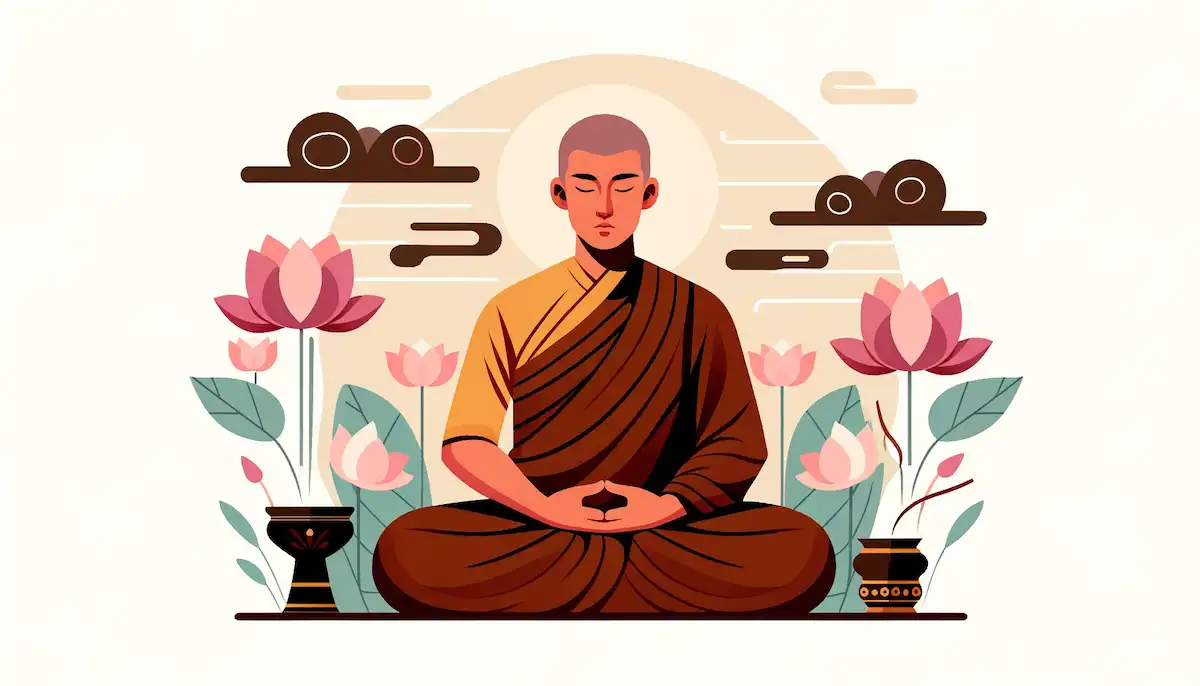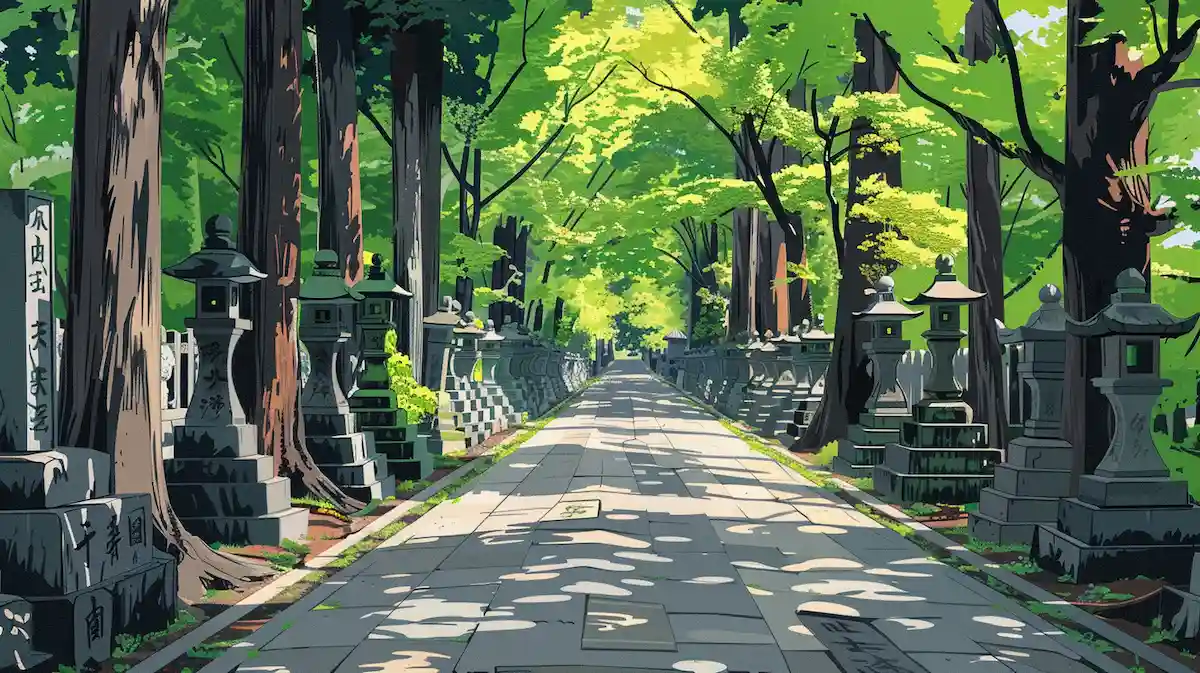高野山を英語で説明・紹介するための基本情報と、英会話に役立つ表現をシンプルでわかりやすい英語で紹介します。
英会話ダイアローグ・関連情報・10の質問を通して、高野山に関する英語表現を学びます。
英語
英会話ダイアローグを読む前に知っておくと良い前提知識と情報は以下の通りです。
- 高野山の基本情報
- 高野山は和歌山県にあり、819年に弘法大師空海によって開かれた日本の重要な霊場
- 真言宗の総本山であり、多くの寺院や歴史的な建造物が存在
- 見どころ
- 金剛峯寺:高野山の中心的な寺院で、多くの重要な仏教行事が行われる
- 奥の院:空海の霊廟があり、約20万基の墓が並ぶ参道が特徴
- 壇上伽藍:重要な宗教的建造物が集まる場所で、高野山の精神的中心地の一つ
- 精進料理
- 精進料理は仏教徒によるベジタリアン料理で、動物性の食材を使用しない
- 高野豆腐や胡麻豆腐などが特徴的な食べ物
- 宿坊体験
- 宿坊は寺院に宿泊することで、修行僧の生活を体験できる
- 朝のお勤めに参加したり、精進料理を食べたりすることができる
- アクセス方法
- 大阪から南海電鉄を利用し、極楽橋駅からケーブルカーで高野山駅まで行き、バスで高野山の中心地へ移動する
2人が高野山の見どころ、精進料理、アクセス方法、訪れるベストシーズンなどについて話しています。
また、宿坊での体験や地元の食事についても話題にしています。
会話 / dialogue

Hey Key, I heard you visited Koyasan recently. It’s quite popular among tourists, right?

Yes, it’s very popular, especially with those interested in Japan’s spiritual and cultural heritage. Did you know it was founded back in 819 by Kobo Daishi, also known as Kukai?

That’s quite historic! What would you say are the must-see attractions there?

Definitely check out Kongobuji Temple and Okunoin. Okunoin, in particular, is amazing with its old cemetery that stretches out across the forest.

I’m planning to go there this autumn. Is that a good time?

Absolutely! The autumn colors make Koyasan incredibly beautiful. The whole mountain is vibrant with reds and yellows.

Sounds picturesque! I’m also thinking about staying in a shukubo. What’s that like?

Staying in a shukubo is a unique experience. You get to live like the monks and eat shojin-ryori, vegetarian meals prepared in the Buddhist tradition. The food, including dishes like Koyadofu and Goma Dofu, is not only delicious but also creatively made.

That shojin-ryori sounds interesting. Is it all vegetarian?

Yes, all shojin-ryori dishes are vegetarian, following Buddhist principles of non-harm. The creativity in the cuisine comes through in how ingredients like sesame are used to craft dishes such as Goma Dofu, adding a rich, creamy texture.

And how do I get there from Osaka?

It’s quite convenient. Just take the Nankai Railway from Namba to Gokurakubashi, then a cable car up to Koyasan.

Sounds easy enough. What should I definitely not miss?

Don’t miss the Danjo Garan Complex. It’s a key part of Koyasan’s spiritual landscape. Also, walking through the cemetery in Okunoin during the evening is unforgettable.

Great, I’ll make sure to check those out. Thanks for all the info, Key!

No problem, Mack. You’ll love it. Koyasan is a place where you can truly feel the depth of Japanese spirituality.
関連情報 / related information
「高野山」について、理解を深めるための「英語での関連情報」です。
高野山

Introduction to Koyasan
Koyasan is a sacred mountain located in Wakayama Prefecture, Japan. It was founded in 819 by Kobo Daishi, also known as Kukai. This mountain is an important center for Shingon Buddhism, a major Buddhist sect in Japan. Many pilgrims and tourists visit Koyasan to experience its spiritual and historical significance.
Main Attractions
One of the key sites in Koyasan is Kongobuji Temple, the head temple of the Shingon sect. Nearby, Okunoin Cemetery is a must-see, famous for its path lined with over 200,000 tombstones leading to Kukai’s mausoleum. Another significant spot is the Danjo Garan Complex, a group of important religious buildings and stupas.
Cultural Experience
Visitors to Koyasan can stay in shukubo, temple lodgings, where they can experience the daily life of monks. These lodgings offer a chance to participate in morning prayers and eat shojin-ryori, traditional Buddhist vegetarian cuisine. Shojin-ryori includes dishes like Koyadofu (freeze-dried tofu) and Goma Dofu (sesame tofu), known for their health benefits and unique flavors.
Access to Koyasan
Getting to Koyasan is straightforward. From Osaka, take the Nankai Railway to Gokurakubashi Station, then switch to a cable car that goes up to Koyasan Station. From there, buses are available to take visitors to the main areas of the mountain. This journey offers scenic views and a peek into Japan’s lush landscapes.
10の質問 / 10 questions
「高野山」について、理解を深めるための「英語での10の質問」です。
1: What is Koyasan?
Koyasan is a sacred mountain in Wakayama Prefecture, Japan, and is the headquarters of Shingon Buddhism. It was founded in 819 by Kobo Daishi, also known as Kukai.
2: Why is Koyasan important in Japanese culture?
Koyasan is important because it is a major pilgrimage site and a center of Buddhist study and practice. It also represents a unique blend of religious, historical, and natural significance.
3: What can visitors see in Koyasan?
Visitors can see many ancient temples, the Kongobuji Temple, the Okunoin Cemetery with its thousands of tombstones, and traditional shukubo (temple lodgings).
4: What is Okunoin?
Okunoin is the site of Kobo Daishi's mausoleum, surrounded by Japan’s largest cemetery. It is considered one of the most sacred places in Koyasan.
5: What are shukubo?
Shukubo are temple lodgings where visitors can stay overnight. Guests can experience traditional monk lifestyles, including eating shojin-ryori (vegetarian cuisine) and participating in morning prayers.
6: What is shojin-ryori?
Shojin-ryori is a type of vegetarian cuisine based on Buddhist ethical principles. It is made without meat or fish and features seasonal vegetables and tofu products.
7: How do you get to Koyasan from Osaka?
From Osaka, you can take the Nankai Railway to Gokurakubashi Station, then transfer to a cable car up to Koyasan Station. Buses are available from there to central Koyasan.
8: What is the best time to visit Koyasan?
The best times to visit Koyasan are during spring, for the cherry blossoms, and autumn, for the colorful fall leaves.
9: What is unique about the temples in Koyasan?
The temples in Koyasan are unique because they are part of a deeply spiritual environment and have a long history tied to the development of Shingon Buddhism in Japan.
10: What activities can visitors do in Koyasan?
Visitors can participate in guided tours, meditation sessions, sutra copying, and attend morning prayers, providing a deep cultural and spiritual experience.
和訳付
会話 / dialogue

Hey Key, I heard you visited Koyasan recently. It’s quite popular among tourists, right?
ねえキー、最近高野山に行ったって聞いたよ。観光客にかなり人気があるんだってね?

Yes, it’s very popular, especially with those interested in Japan’s spiritual and cultural heritage. Did you know it was founded back in 819 by Kobo Daishi, also known as Kukai?
ええ、特に日本の精神的・文化的遺産に興味がある人には非常に人気があるよ。819年に弘法大師、別名空海によって創設されたのを知ってる?

That’s quite historic! What would you say are the must-see attractions there?
それはかなり歴史的だね!どの見どころが必見だと思う?

Definitely check out Kongobuji Temple and Okunoin. Okunoin, in particular, is amazing with its old cemetery that stretches out across the forest.
絶対に金剛峯寺と奥の院をチェックしてみて。特に奥の院は、森を抜ける古い墓地がすごいよ。

I’m planning to go there this autumn. Is that a good time?
この秋に行く予定なんだ。いい時期かな?

Absolutely! The autumn colors make Koyasan incredibly beautiful. The whole mountain is vibrant with reds and yellows.
もちろん!秋の紅葉が高野山を信じられないほど美しくしてくれるよ。山全体が赤や黄色で生き生きとしているんだ。

Sounds picturesque! I’m also thinking about staying in a shukubo. What’s that like?
絵に描いたようだね!僕も宿坊に泊まることを考えているんだけど、どんな感じ?

Staying in a shukubo is a unique experience. You get to live like the monks and eat shojin-ryori, vegetarian meals prepared in the Buddhist tradition. The food, including dishes like Koyadofu and Goma Dofu, is not only delicious but also creatively made.
宿坊に泊まるのはユニークな体験だよ。僧侶のように暮らして、仏教の伝統に基づいた精進料理を食べることができる。高野豆腐や胡麻豆腐のような料理を含む食事は、美味しいだけでなく創造的に作られているんだ。

That shojin-ryori sounds interesting. Is it all vegetarian?
その精進料理は面白そうだね。全部ベジタリアン料理?

Yes, all shojin-ryori dishes are vegetarian, following Buddhist principles of non-harm. The creativity in the cuisine comes through in how ingredients like sesame are used to craft dishes such as Goma Dofu, adding a rich, creamy texture.
ええ、全ての精進料理は仏教の不殺生の原則に従ったベジタリアン料理だよ。胡麻のような食材を使って胡麻豆腐のような料理を作る際の創造性が料理に表れていて、リッチでクリーミーな食感を加えているんだ。

And how do I get there from Osaka?
大阪からどうやって行けるの?

It’s quite convenient. Just take the Nankai Railway from Namba to Gokurakubashi, then a cable car up to Koyasan.
とても便利だよ。難波から南海電鉄に乗って極楽橋まで行き、そこからケーブルカーで高野山まで上がるんだ。

Sounds easy enough. What should I definitely not miss?
それなら簡単そうだね。絶対に見逃せないものは何?

Don’t miss the Danjo Garan Complex. It’s a key part of Koyasan’s spiritual landscape. Also, walking through the cemetery in Okunoin during the evening is unforgettable.
壇上伽藍(だんじょうがらん)を見逃さないで。それは高野山の精神的な景観の重要な部分だよ。また、夕方に奥の院の墓地を歩くのは忘れられない体験になるよ。

Great, I’ll make sure to check those out. Thanks for all the info, Key!
いいね、それらを確認するようにするよ。情報をありがとう、キー!
関連情報 / related information
高野山

Introduction to Koyasan
Koyasan is a sacred mountain located in Wakayama Prefecture, Japan. It was founded in 819 by Kobo Daishi, also known as Kukai. This mountain is an important center for Shingon Buddhism, a major Buddhist sect in Japan. Many pilgrims and tourists visit Koyasan to experience its spiritual and historical significance.
高野山の紹介
高野山は和歌山県にある神聖な山で、819年に弘法大師(空海としても知られている)によって創設されました。この山は日本の主要な仏教宗派である真言宗の重要な中心地です。多くの巡礼者や観光客がその霊的および歴史的な重要性を体験するために訪れます。
Main Attractions
One of the key sites in Koyasan is Kongobuji Temple, the head temple of the Shingon sect. Nearby, Okunoin Cemetery is a must-see, famous for its path lined with over 200,000 tombstones leading to Kukai’s mausoleum. Another significant spot is the Danjo Garan Complex, a group of important religious buildings and stupas.
主な見どころ
高野山の主要な観光地の一つは、真言宗の総本山である金剛峯寺です。近くには、20万以上の墓石が並ぶ参道で有名な奥の院があり、見逃せません。もう一つの重要な場所は、重要な宗教建築物と塔が集まる壇上伽藍です。
Cultural Experience
Visitors to Koyasan can stay in shukubo, temple lodgings, where they can experience the daily life of monks. These lodgings offer a chance to participate in morning prayers and eat shojin-ryori, traditional Buddhist vegetarian cuisine. Shojin-ryori includes dishes like Koyadofu (freeze-dried tofu) and Goma Dofu (sesame tofu), known for their health benefits and unique flavors.
文化体験
高野山を訪れる人々は、宿坊(寺院の宿泊施設)に泊まることができ、そこで僧侶の日常生活を体験することができます。これらの宿泊施設では、朝の祈りに参加したり、精進料理(伝統的な仏教のベジタリアン料理)を食べる機会が提供されます。精進料理には、健康効果とユニークな味で知られる高野豆腐や胡麻豆腐などの料理が含まれます。
Access to Koyasan
Getting to Koyasan is straightforward. From Osaka, take the Nankai Railway to Gokurakubashi Station, then switch to a cable car that goes up to Koyasan Station. From there, buses are available to take visitors to the main areas of the mountain. This journey offers scenic views and a peek into Japan’s lush landscapes.
高野山へのアクセス
高野山へのアクセスは簡単です。大阪から南海電鉄で極楽橋駅まで行き、そこから高野山駅に向かうケーブルカーに乗り換えます。そこからバスが利用可能で、訪問者を山の主要エリアに連れて行きます。この旅は、美しい景観と日本の豊かな自然を垣間見ることができます。
10の質問 / 10 questions
1: What is Koyasan?
高野山とは何ですか?
Koyasan is a sacred mountain in Wakayama Prefecture, Japan, and is the headquarters of Shingon Buddhism. It was founded in 819 by Kobo Daishi, also known as Kukai.
高野山は和歌山県にある神聖な山で、真言宗の総本山です。819年に弘法大師(空海としても知られる)によって創設されました。
2: Why is Koyasan important in Japanese culture?
高野山は日本文化においてなぜ重要ですか?
Koyasan is important because it is a major pilgrimage site and a center of Buddhist study and practice. It also represents a unique blend of religious, historical, and natural significance.
高野山は重要な巡礼地であり、仏教の学問と実践の中心地であるため重要です。また、宗教的、歴史的、自然的な意義を独自に融合しています。
3: What can visitors see in Koyasan?
高野山では何を見ることができますか?
Visitors can see many ancient temples, the Kongobuji Temple, the Okunoin Cemetery with its thousands of tombstones, and traditional shukubo (temple lodgings).
訪問者は多くの古代寺院、金剛峯寺、何千もの墓石がある奥の院、そして伝統的な宿坊(寺院の宿泊施設)を見ることができます。
4: What is Okunoin?
奥の院とは何ですか?
Okunoin is the site of Kobo Daishi's mausoleum, surrounded by Japan’s largest cemetery. It is considered one of the most sacred places in Koyasan.
奥の院は、日本最大の墓地に囲まれた弘法大師の霊廟がある場所です。高野山で最も神聖な場所の一つとされています。
5: What are shukubo?
宿坊とは何ですか?
Shukubo are temple lodgings where visitors can stay overnight. Guests can experience traditional monk lifestyles, including eating shojin-ryori (vegetarian cuisine) and participating in morning prayers.
宿坊は訪問者が宿泊できる寺院の宿泊施設です。宿泊者は精進料理(ベジタリアン料理)を食べたり、朝のお勤めに参加するなど、伝統的な僧侶の生活を体験できます。
6: What is shojin-ryori?
精進料理とは何ですか?
Shojin-ryori is a type of vegetarian cuisine based on Buddhist ethical principles. It is made without meat or fish and features seasonal vegetables and tofu products.
精進料理は仏教の倫理原則に基づくベジタリアン料理の一種です。肉や魚を使わず、季節の野菜や豆腐製品が特徴です。
7: How do you get to Koyasan from Osaka?
大阪から高野山へはどのようにして行きますか?
From Osaka, you can take the Nankai Railway to Gokurakubashi Station, then transfer to a cable car up to Koyasan Station. Buses are available from there to central Koyasan.
大阪からは南海電鉄を利用して極楽橋駅まで行き、そこからケーブルカーで高野山駅まで上がります。そこからバスで高野山の中心地まで行くことができます。
8: What is the best time to visit Koyasan?
高野山を訪れるのに最適な時期はいつですか?
The best times to visit Koyasan are during spring, for the cherry blossoms, and autumn, for the colorful fall leaves.
高野山を訪れるのに最適な時期は、春の桜の季節と、秋の紅葉の季節です。
9: What is unique about the temples in Koyasan?
高野山の寺院には何がユニークですか?
The temples in Koyasan are unique because they are part of a deeply spiritual environment and have a long history tied to the development of Shingon Buddhism in Japan.
高野山の寺院は、深い霊性の環境の一部であり、日本の真言宗の発展に関連する長い歴史を持っているため、ユニークです。
10: What activities can visitors do in Koyasan?
高野山で訪問者はどのような活動ができますか?
Visitors can participate in guided tours, meditation sessions, sutra copying, and attend morning prayers, providing a deep cultural and spiritual experience.
訪問者はガイド付きツアーや瞑想セッション、写経、朝のお勤めに参加することができ、深い文化的および霊的な体験を提供します。
words & phrases
英会話ダイアローグと関連情報に出てきた単語・フレーズです(例文は各3つ)。

vibrant : 形容詞
意味: 色が鮮やかな、活気ある。Full of energy and enthusiasm.
(高野山の秋の紅葉を色鮮やかで活気あると形容する)
例文:
The city is vibrant with its bustling nightlife.
「その都市は活気ある夜の生活で鮮やかです。」
She wore a vibrant dress that stood out in the crowd.
「彼女は群衆の中で目立つ鮮やかなドレスを着ていました。」
The discussion became more vibrant as everyone joined in.
「皆が参加すると議論がさらに活気づきました。」
picturesque : 形容詞
意味:絵画のように美しい。Charmingly or quaintly attractive, especially in a quaint or pretty style.
(高野山の景色が絵画のように美しいと述べている)
例文:
We walked through a picturesque village nestled in the mountains.
「私たちは山に囲まれた絵のように美しい村を歩きました。」
The old bridge was very picturesque.
「その古い橋はとても風情がありました。」
He took a picturesque route along the coast.
「彼は海岸沿いの風光明媚なルートを選びました。」
texture : 名詞
意味:触感、質感。The feel, appearance, or consistency of a surface or substance.
(料理の質感を表現する際に使用)
例文:
The texture of the fabric was soft and smooth.
「その布の質感は柔らかく滑らかでした。」
This cake has a light and airy texture.
「このケーキは軽くて空気を含んだ質感があります。」
He enjoys the creamy texture of yogurt.
「彼はヨーグルトのクリーミーな質感が好きです。」
tombstones : 名詞
意味:墓石。A stone that marks a grave.
(奥の院の参道にある墓石について述べる)
例文:
The cemetery was filled with old, weathered tombstones.
「その墓地は古く風化した墓石でいっぱいでした。」
Each tombstone in the field bore the name of a soldier.
「野原の各墓石には兵士の名前が刻まれていました。」
We cleaned the moss off the tombstones.
「私たちは墓石の苔を掃除しました。」
mausoleum : 名詞
意味:霊廟。A large and stately tomb or building housing such a tomb or several tombs.
(高野山の奥の院にある空海の霊廟について言及する)
例文:
The emperor was buried in a grand mausoleum.
「その皇帝は壮大な霊廟に埋葬されました。」
They visited the mausoleum to pay their respects.
「彼らは敬意を表して霊廟を訪れました。」
The mausoleum stood silent and majestic on the hill.
「その霊廟は丘の上で沈黙し、荘厳に佇んでいました。」
詳細情報 / Further Info
関連記事(弘法大師 空海)

